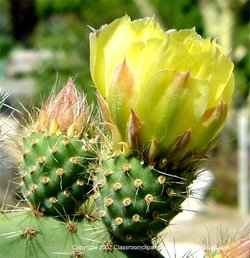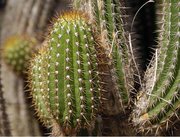Cactus
|
|
| Cacti | ||||||||||
|---|---|---|---|---|---|---|---|---|---|---|
 Cactus Flower. Image provided by Classroom Clipart (http://classroomclipart.com)]] | ||||||||||
| Scientific classification | ||||||||||
| ||||||||||
| Genera | ||||||||||
|
Many, see text |
A cactus (plural, cacti or cactuses) is a type of (usually) succulent plant belonging to the dicotyledonous flowering plant family, Cactaceae. The Cactaceae has (depending upon the authority) between 24 and 220 genera, with around 90 genera being the most widely accepted count, and with anywhere from 1,500 to 1,800 species. Cacti are well-known natives of the Americas, mostly in desert areas. Some are also rainforest epiphytes, growing on tree branches where, despite the high rainfall, water drains off quickly so that "dry" conditions prevail much of the time.
Cacti are almost exclusively New World plants. This means that they are native only in North America and South America. There is however one exception, Rhipsalis baccifera; this species has a pantropical distribution, occurring in the Old World in tropical Africa, Madagascar and Sri Lanka as well as in tropical America. This plant is thought to be a relatively recent colonist in the Old World (within the last few thousand years), probably carried as seeds in the digestive tracts of migratory birds. Many other cacti have become naturalized to similar environments in other parts of the world after being introduced by man.
Although many other succulent plants exist in the Old World, even a few with spines, they are not cacti because they lack areoles. These specialized structures are unique to cacti and identify the family.
Cacti are believed to have evolved in the last 30 to 40 million years. Long ago, the Americas were joined to the other continents, but separated due to continental drift. Unique species in the New World must have developed after enough the continents had moved apart. Significant distance between the continents was only achieved around in the last 50 million years. It is assumed this explains why cacti do not occur in Africa; the continents had already separated when cacti evolved.
Like other succulents, cacti are well-adapted to life with little precipitation. The leaves have evolved into spines, which in addition to allowing less water to evaporate than regular leaves, defend the cactus against water-seeking animals. Photosynthesis is carried out by enlarged stems, which also store water. Unlike many other succulents, the stem is the only part of a true cactus where this takes place. Very few members of the family have leaves, and when present these are usually rudimentary and soon fall off; they are typically awl-shaped and only 1-3 mm long. Two genera, Pereskia and Pereskiopsis, do however retain large, non-succulent leaves 5-25 cm long, and also non-succulent stems; they are possibly primitive genera, thought to be closely similar to the plants that cacti evolved from.

Cacti come in many varieties in a wide range of shapes and sizes. Some grow to great size. Some cacti produce beautiful flowers, which like spines and branches arise from areoles. Many cactus species are night-blooming, as they are pollinated by nocturnal insects or small animals, principally moths and bats. Cacti range from small and round to pole-like and tall, such as the Saguaro.
A number of cactus species are cultivated for use as houseplants, as well as for ornamental gardens. They often form part of xerophilic (dry) gardens in arid regions. Some cacti bear edible fruit.
Reference
- Edward F. Anderson, The Cactus Family (Timber Press, 2001) ISBN 0-88192-498-9 - Comprehensive and lavishly illustrated
External links
- CactiGuide.com - many photos, and discussion forum (http://www.cactiguide.com/)
- Cactus portal (http://www.cactus-mall.com/)
- Cactus Culture For Amateurs (http://www.gutenberg.net/dirs/1/3/3/5/13357/13357-h/13357-h.htm), by W. Watson, Assistant Curator of the Royal Botanic Gardens, Kew, 1889. Profusely illustrated.
- Growing Cacti from Seed (Plot55.com) (http://plot55.com/growing/general/cacti_seed.html)

